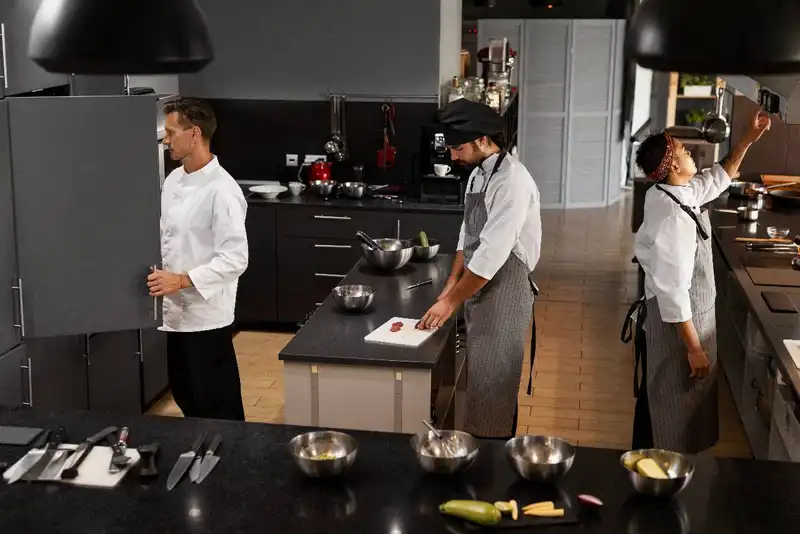What is LMS software?
LMS software is a digital platform that helps businesses create, deliver, and track employee training. It organizes learning materials, monitors progress, and allows easy updates, making training consistent and accessible anytime, especially useful for busy restaurant teams.
How to Design an Effective Employee Training Program for Restaurants
Overview
In the world of restaurants, many restaurants rely on inconsistent or rushed training, which leads to preventable mistakes, high turnover, and uneven service. According to the U.S. Bureau of Labor Statistics, the hospitality industry consistently ranks among the highest for employee turnover - often exceeding 70% annually. That's not just a staffing issue; it's a sign that many employees aren't set up for success from the start.
But it doesn't have to be that way. With a clear and simple training program, your team can learn faster, work better, and stick around longer. When employees know what's expected and feel supported, they're more likely to do a great job and stay with you.
Identify Training Needs by Role

Before you build any training program, you need to know what your team actually needs to learn. Every position in a restaurant comes with different tasks and responsibilities, so training shouldn't be one-size-fits-all. A line cook doesn't need to learn how to greet guests, and a server doesn't need to memorize cooking times. That's why breaking it down by role is the first and most important step.
Start by listing out the key jobs in your restaurant - hosts, servers, bussers, cooks, dishwashers, bartenders, managers - and ask yourself- what does each person need to know to do their job well from day one? Think about the skills, tools, and knowledge each role requires. For example -
1. Front-of-house staff need to learn how to greet guests, use the POS system, take orders correctly, and handle complaints politely.
2. Back-of-house staff should be trained on food prep, portion sizes, cleaning standards, and safe cooking procedures.
3. Managers need skills in scheduling, coaching, and resolving issues quickly.
It also helps to talk to your current team. Ask them what they wish they had known when they started, or where they still feel unsure. If customers are complaining about long wait times or cold food, that's a sign something's missing in your training.
Once you know what each role needs, you can build a training program that teaches those things clearly and step by step. This way, your team gets what they need to succeedand your restaurant benefits every shift.
Perfect Solution for Your Training and Development Needs
Teach Your Staff with Altametrics LMS
Develop a Structured Training Plan
Once you've identified what each role needs to learn, the next step is to build a training plan that's organized and easy to follow. A good plan gives new employees a clear path from their first day to full independence. It also makes sure nothing important is missed along the way.
Start by breaking the training into stages. Most roles can follow a similar flow -
1. Introduction and Orientation - Go over basic policies, safety rules, and what the job involves.
2. Observation and Shadowing - Let new hires watch an experienced team member do the job. This helps them understand the pace and expectations.
3. Hands-On Practice - Give them a chance to try tasks with supervision, whether it's making a salad or taking a guest's order.
4. Check-Ins and Feedback - Schedule regular moments to see how they're doing, answer questions, and fix mistakes early.
Set a realistic timeline. For example, a new server might need five training shifts before working alone, while a line cook might need ten to learn all the stations. Keep it flexible - some people learn faster than others - but have a target so everyone knows what to expect.
Also, make sure training doesn't stop after the first week. A structured plan should include follow-up after 30 or 60 days to check in on performance and offer more coaching if needed.
With a clear plan in place, your team will feel more confident, and you'll avoid the chaos of last-minute, sink-or-swim training.
Create Easy-to-Follow Training Materials
Having the right materials makes training easier for everyone - trainers and new hires alike. When your team has clear instructions, checklists, and visuals to guide them, they're less likely to make mistakes and more likely to feel confident doing their job.
Start with the basics. For each role, write down the tasks they need to know and break them into steps. Turn those steps into checklists or guides that can be used during training. For example -
- A server checklist might include how to greet guests, take an order, enter it into the POS, deliver food, and close out a table.
- A prep cook guide might cover how to wash produce, portion ingredients, follow recipes, and clean their station.
Make your materials easy to understand - avoid long paragraphs and focus on bullet points, simple language, and visual examples. Laminated recipe cards, printed station maps, and cleaning checklists can go a long way in helping staff remember their tasks.
Visuals are especially helpful in the kitchen. Photos showing how a finished dish should look or how to set up a station make training more hands-on and reduce confusion.
Also, make sure your training materials are consistent. Everyone should be teaching the same process in the same way. If one trainer says to do something differently than another, it leads to mixed messages and mistakes.
By giving your team clear and simple tools, you set them up to succeed from day one - and keep your restaurant running smoothly as they learn.
Choose Effective Training Methods

Not everyone learns the same way, and that's especially true in a busy restaurant environment. Some people pick things up quickly by watching, others need to do the task themselves a few times, and some prefer written steps they can refer back to. That's why it's important to use a mix of training methods to reach different types of learners and keep things clear -
Here are a few effective methods to consider
1. Shadowing - Letting new employees follow an experienced team member helps them see how the job is done in real time. It's a low-pressure way to get familiar with routines and expectations.
2. Hands-on practice - After observing, employees should try tasks themselves - like preparing a dish, taking an order, or cleaning a station - with someone nearby to guide and correct them.
3. Written guides and checklists - These provide structure and help new hires remember steps after training ends. Keep them simple and easy to reference.
4. Demonstrations - Have a trainer walk through each task slowly and explain why things are done a certain way. This works well for food prep and safety procedures.
5. Short videos or visual aids - These can reinforce lessons and be reviewed at any time, especially helpful for menu items or POS system walkthroughs.
The key is to break training into small parts and give new hires time to absorb each one. Don't rush the process. When you combine different methods, you make learning easier and more effective for everyone - no matter their background or experience.
Prepare and Support Your Trainers
A great training program isn't just about what's being taught - it's also about who's doing the teaching. Even the best training plan can fall apart if the person leading it isn't prepared, consistent, or patient. That's why choosing the right trainers and supporting them properly is just as important as the training materials themselves.
Start by picking team members who are not only skilled at their jobs but also communicate clearly, lead by example, and stay calm under pressure. Just because someone is fast or experienced doesn't always mean they're a good teacher. Look for people who are respectful, approachable, and willing to explain things step by step.
Once you've chosen your trainers, make sure they're on the same page. Give them the training checklists, expectations, and goals. Walk them through the training timeline and materials so they know exactly what to cover and when. If every trainer is teaching things a different way, new employees will end up confused - and that leads to mistakes.
Check in with your trainers regularly. Ask what's working, what's not, and where new hires might be struggling. Be open to adjusting your plan based on their feedback.
Also, remember to give trainers enough time and space to train properly. Don't expect them to handle a full shift's workload while also walking someone through new tasks. Training takes patience and focus - and your trainers need to feel supported in doing it right.
When your trainers are prepared and confident, your whole team benefits.
Leverage LMS Software to Streamline Training
Using Learning Management System (LMS) software can make training easier and more organized for your restaurant team. Here are the main ways an LMS helps -
Centralized Training Materials
You can upload videos, quizzes, checklists, and other resources all in one place. Employees can access these materials anytime, whether they're at home or during breaks. This helps new hires start learning before their first shift and review lessons whenever needed.
Track Employee Progress
An LMS lets you see who has completed each training module, how well they did on quizzes, and where they may need extra help. This way, managers can quickly spot training gaps and provide additional support.
Easy Updates
If your menu changes or new safety rules come in, you can quickly update the training content. The LMS will make sure everyone has access to the latest information, keeping your team up to date.
Mobile Access
Many LMS platforms work well on smartphones and tablets, which is perfect for restaurant staff who are often moving around. This flexibility means training can happen anytime, anywhere.
Supports Hands-On Training
While LMS software doesn't replace in-person practice, it provides a consistent knowledge base. It frees up managers' time and ensures everyone learns the essentials in the same way.
Using an LMS can streamline your training process, helping your team learn faster and stay informed - making your restaurant run more smoothly.
Foster a Culture of Continuous Learning
Training shouldn't be seen as a one-time task that ends after the first week. Instead, it should become a regular part of your restaurant's culture. When learning is ongoing, employees stay sharp, feel valued, and are better prepared to handle new challenges.
Start by encouraging regular refreshers. This can be short sessions during team meetings or quick reviews at the start of a shift. For example, you might go over a menu change, a new safety procedure, or a customer service tip once a week. These small, frequent reminders help keep everyone on the same page.
Cross-training is another powerful tool. Teach employees to perform multiple roles - like a server who can help with bussing or a cook who knows basic prep tasks. This flexibility makes your team stronger, especially during busy times or when someone calls in sick.
Create an environment where employees feel comfortable asking questions and giving feedback. Open communication lets you spot training gaps early and shows your staff that their growth matters.
Finally, recognize and reward learning efforts. Whether it's praising someone for mastering a new skill or offering small incentives for completing training modules, acknowledgment boosts motivation.
Looking for Training Your Employees Effectively?
Elevate Your Training and Development with Altametrics LMS









































































































































































































































































